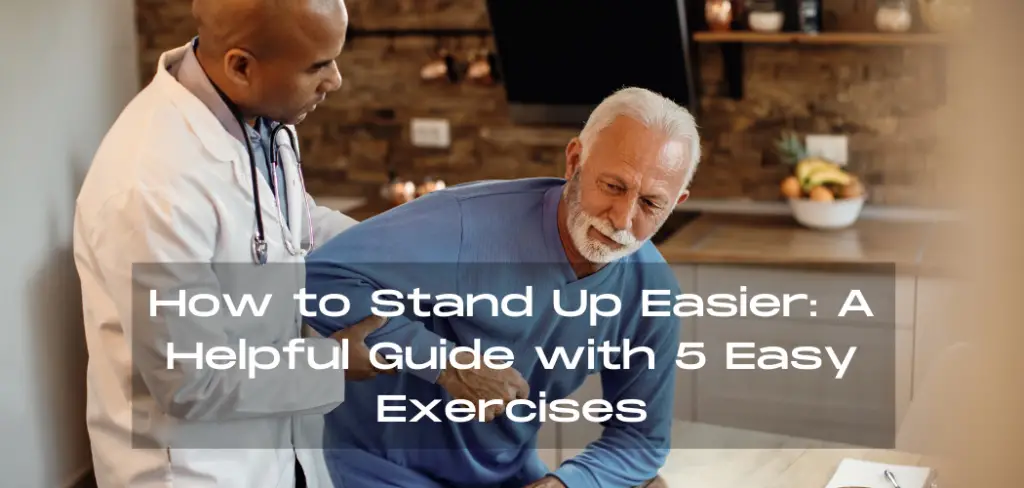Do you find yourself getting up from a chair more slowly as you get older? You’re not alone. Many people have difficulty standing up from a chair, whether it’s due to age, injury, or simply have had strength losses that snuck up on you.
In this blog post, we will review how to stand up easier and with less pain from a chair. We’ll also discuss proper techniques and provide exercises that can help make it easier to get out of a chair and with more balance and stability.

Getting out of a chair can be quite challenging, and often results in pain and discomfort. However, it’s a skill that is extremely important for daily life and one that you should continue to practice.
Why is Getting Out of a Chair Difficult?
There are a few reasons why getting out of a chair can be challenging. This includes having to fight gravity, the angle of our joints when we are in a chair, and the force we have to create to move a sedentary mass.
The first reason is that when we try to stand up, we are having to fight gravity with our weakened muscles. Overcoming the force of gravity PLUS having to lift our own body weight out of a chair requires a large force. If we have any weakness in our legs, it becomes apparent quite quickly.
You might be fine if you use your hands to get you started moving or if you can rock your body to get momentum to get out of the chair. However, these are clear signs that you don’t have enough strength in your legs that’s needed to stand up from the chair.

Another reason is the angles of our joints are at less than optimal angles for our muscles to work when we are sitting position. When our knees and our hips are bent to 90-degrees, it places them in a position that is hard to produce an immediate and large force.
The angles of our joints put our muscles at a disadvantage to work at their best capacity further exacerbating any weakness present in the legs.
Finally, when we stand up from a chair, we have to go from a stationary position of sitting into a movement of standing up. We don’t get to harness the power of momentum!
If you were to go from a standing position to a sitting position and back to a standing position it’s a lot easier than going from sitting to standing. Why?
Because we use momentum and the elastic ability of our tendons to bring us back up to standing as opposed to starting from a standing position.
Proper Technique to Stand Up From a Chair
Now that we know some of the reasons why getting out of a chair is difficult, let’s review the proper technique for rising from a chair.
When getting up from a chair, it’s important to have the proper techniques to make it easier and safer on your whole body. It’s important to focus on using our leg muscles and not our back muscles. This will help us stand up with less effort and proper form.
Scoot to the front of the Chair
When getting up from a chair, it’s important to move our body weight closer to the front edge of the chair. This will help us stand up with less effort.
If we stay seated in the middle of the chair, it makes it more challenging to stand up because we have to lift our entire body weight and we have to move it forward a greater distance.
Scooting towards the front of the chair allows us to use our leg muscles and not our back muscles to stand up and position our body weight in the optimal location to get up.
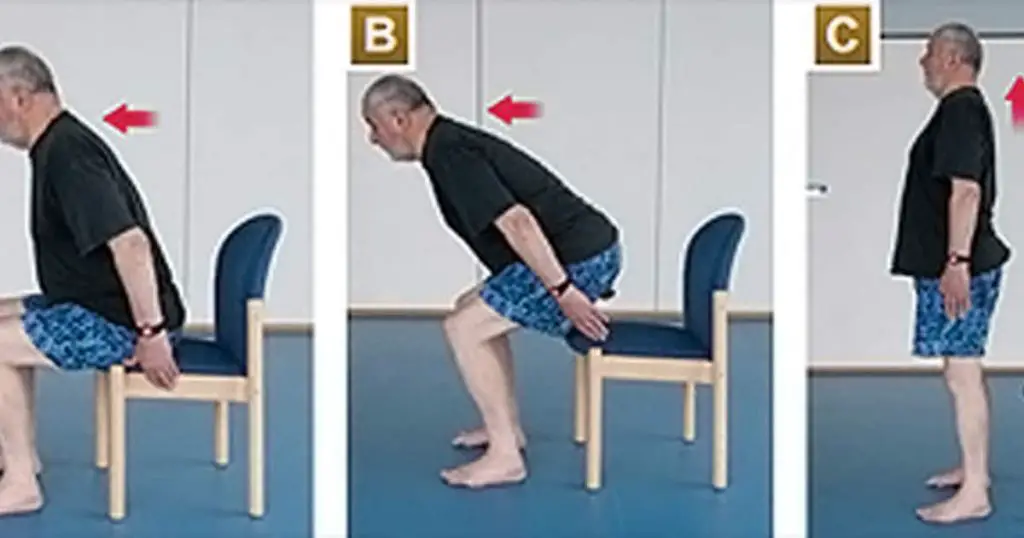
Lean Forward at the Trunk
Once we’ve scooted to the front of the chair, it’s important to lean forward from our hips as we begin to stand up. This again moves our body weight over the top of our feet and legs that it’s easier to control.
If we lean forward from our hips, it allows us to use our leg muscles more effectively.
Try to stand up without leaning forward. It makes it really difficult to do.
You end up using your back muscles more and it puts us at risk for injury as well as making it much more difficult to stand up.
You know if you aren’t leaning forward enough if you tip backward when you’re trying to stand up. This is a clear sign that your center of gravity is too posterior and you aren’t getting the center of gravity forward.
Drive Through your Legs
Once we’ve leaned forward from your hips, it’s important to really drive through our legs to push you up out of the chair. We have to push through our quads and hip muscles to get us upright.
If we try to stand up without driving through our legs, it’s nearly impossible to get out of the chair.
Imagine that you are trying to push as hard as you can through the heels of your feet as you are getting out of the chair.
Driving through the legs makes the knees straighten and it pushes the hips forward, causing the body to straighten up and thus making you stand nice and tall.
Lift your Head and Chest Up
When you lean your body weight forward, your head is facing down to the ground.
This helps bring your weight forward but once you start to stand up and your hips start to come forward, you need to get your chest up at the SAME TIME. If you don’t raise your head the body will just keep moving forward and you’ll tip over onto your face.
Bringing your chest up helps keep your balance and makes it a lot easier to get upright after getting out of a chair.
Exercises to make Sit-to-Stand Easier
If you find that you have difficulty with a sit-to-stand task aka getting out of a chair, then it’s time to consider performing exercises that can help improve your strength. The stronger that your legs get, especially the quads and glutes, the easier it is to get out of a chair.
As with any strengthening program, it can take at least 6 weeks before you notice a large change. That means you have to be patient and continue to be diligent each week.
Once it’s easier to get out of a chair, that doesn’t mean that you can stop doing these exercises either. It means that you have only scratched the surfaces and there is more room to increase your strength.
Muscle strength is a “use it or lose it” gain. If you stop working on strength then the muscles atrophy quickly.
Counter Squats
The counter squat is a great exercise to help increase the strength and power in the quadriceps muscles. This will also help you stand up easier from a chair.
To do a counter squat, stand facing a countertop or sturdy surface with your hands holding on top for support.
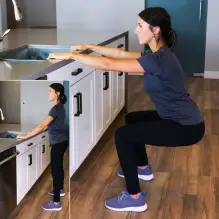
Place your feet about hip-width apart and then slowly lower yourself down into a seated position. Make sure to keep your hips back as you squat down and don’t let your knees go past your toes.
Drive through your heels to stand up, making sure to use your quadriceps muscles. If you feel wobbly when standing, hold onto the counter for stability. Keep working on getting lower in your squat each day.
Repeat this exercise 12-15 times, 3 sets per day.
Bridges
Bridges are a great exercise to help increase the strength and power in the gluteal muscles.
To do a bridge, lie on your back with feet flat on the ground and shoulder-width apart, legs bent to 90 degrees.
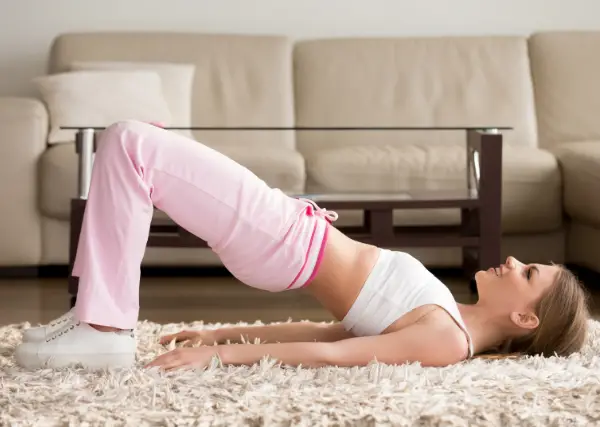
Tighten your abdominal muscles and drive through your heels to lift your hips off the ground and towards the ceiling. Keep your core engaged so that your hips stay in line with your shoulders and knees.
Hold for two seconds before lowering yourself back down to the starting position. Repeat this exercise 12-15 times, 2 sets per day.
Long Arc Quads
Long arc quads are a great exercise to help increase the range of motion in your knees and increase the strength in your quadriceps muscles.
To do long arc quads, sit on a chair or elevated surface such as your bed with your knees bent.
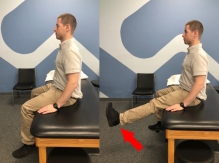
Slowly straighten your leg by squeezing your thigh muscles until your leg is all the way straight in front of you. Hold for two seconds before lowering the leg back to the starting position.
To make it more challenging we recommend using a small loop resistance band around both ankles or using a small ankle weight around the leg.
Repeat this exercise 12-15 times, 3 sets per day.
Single-Leg Balance Timed Holds
Single-leg balance holds are a great exercise to help improve your balance, coordination, and muscular endurance.
To do single-leg balance holds, stand on one foot with your knee bent as much as you can pain-free. You’ll feel the muscles of your thigh, calf, and hip engage.
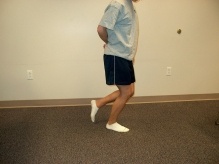
Hold this position for 30 seconds before switching legs. Repeat 4-5 sets per day.
You’ll feel your muscles fatigue and get tired fairly quickly but try and see if you can hold out for the entire 30 seconds.
To make this exercise easier, place a finger or two on something to support you such as the kitchen counter.
To make this more challenging, try closing your eyes or using a foam balance pad to make the surface more unstable.
Step-Ups on a Step
Another great exercise to help improve your strength and power in the quads and glutes is step-ups.
To do a step-up, stand in front of a step or bench with your left foot on top of the step. Drive through your heel to lift yourself up onto the step, making sure to use your quadriceps muscles.
Step back down with your left leg and then repeat with the right leg. Do 3 sets of 12-15 repetitions per day.
Try not to push or vault yourself up with the bottom leg, but rather make the leg on top of the step pull you up.
Conclusion
There are a lot of different exercises that you can do to help make it easier to stand up from a chair. By increasing the strength and power in your quadriceps, glutes, and hamstrings, as well as improving your balance and coordination, you’ll be rising out of your chair with ease in no time!
Do you have any tips or exercises that have helped you stand up easier from a chair? Share them in the comments below.
Disclaimer: The information provided in this post is for educational purposes only. This is not a substitute for a medical appointment. Please refer to your physician before starting any exercise program.
